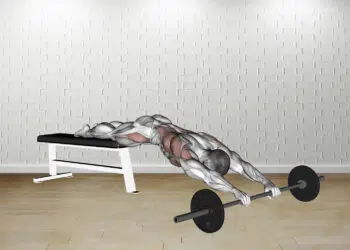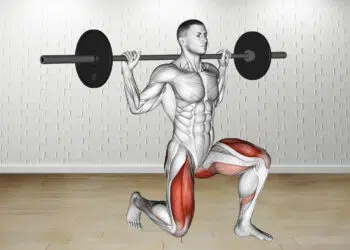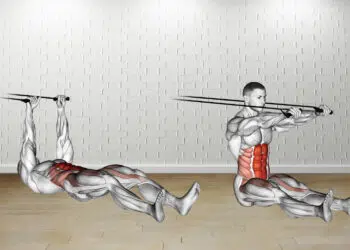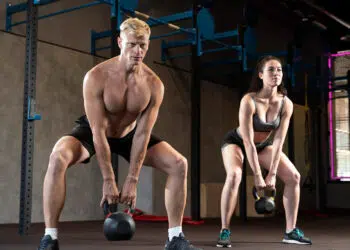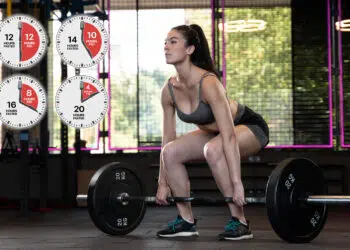The cable standing row (V-bar) makes a great addition to any back workout. It’s not your conventional back exercise but that makes it no less effective for building the muscles of the upper posterior chain. You won’t be able to use maximum loads with this movement but that’s not the point. It’s all about focus and isolation to improve your muscular development.
We’ll show you how to do it, offer some tips, give you a few variations and show you how to incorporate it into your training routine.
Here’s a guide to the cable standing row (V-bar)
Muscles Worked
Several muscles are involved in this exercise. Here’s some basic information on each one.
- Infraspinatus – A portion of the rotator cuff, infraspinatus muscle is a component of the glenohumeral joint’s formation which help to facilitate stability and movement (external rotation, scaption and lateral rotation) of the shoulder.
- Latissimus Dorsi – Grouped with the trapezius and rhomboid muscles, latissimus dorsi is functionally linked to the scapula and helps to produce movement of the arm at the shoulder joint. One example is lifting the trunk forward and upward when performing a pull-up.
- Teres Major – The teres major is one of several muscles associated with the scapulohumeral joint and it works synergistically with the latissimus dorsi to extend, adduct, and internally rotate the shoulder.
- Teres Minor – A long muscle extending from the scapula to the arm bone, teres minor helps comprise rotator cuff with the help of a few other muscles including infraspinatus. Its movements include rotation and abduction of the arm.
- Trapezius Lower Fibers – The trapezius muscles are divided into three sections of which the lower fibers differ from middle and upper traps that move the scapula either up or down. Rather the middle traps can retract the scapula like when you pull your shoulder back before rowing.
- Trapezius Middle Fibers –
- Brachialis – Brachialis is a pull and curl focused muscle, being the most prominent elbow flexor that starts in the upper arm and crosses down through the elbow joint. Cable rows are a great opportunity to train the brachialis forearm muscles and all the pulling muscles in the arm.
- Brachioradialis – The forearm’s brachioradialis also pulls some of the weight as an elbow flexor and forearm supinator and pronator in its own right.
- Deltoid Posterior – The deltoid posterior or rear delts are found by touching the back of your arm above the triceps muscles. While we hardly see the rear deltoids, they do provide an important function which is to pull shoulder blades and arms rearward toward the back of your body.
- Pectoralis Major Sternal Head – The lower portion of your chest is referred to as the sternal head because it separates from the other section of your pec muscles. Anatomically, the sternal lower is involved when the arms are pulled downward and inward (adduction).
How To Do The Cable Standing Row (V-bar)
There’s nothing complex about this movement, which is great because it’s effective and doesn’t require much setup. Here are step-by-step instructions for this exercise.
- Attach a V bar on the cable pulley about lower chest height.
- Grip the bar with both hands and take a few steps back away from the cable machine.
- With your feet about hip-width apart, knees slightly bent, chest up, and shoulder blades back, use your back muscles to pull the weight by driving your elbows behind your body. You should be pulling the handles just below your chest.
- Slowly extend your arms forward while maintaining the same body position and repeat.
Here’s a video example…
Cable standing row (V-bar) tips
- You may not be able to use maximum poundages with this exercise due to the setup, and it’s not necessary either. Choose a weight that won’t cause you to compromise your form and technique, and really focus on the contraction as this is not an exercise that you should be using cheat reps with.
- Feel free to use any bar attachment other than the V-shaped bar. You can even attach two single-grip handles to the pulley to replicate the V-bar row if you don’t have a V bar.
- Avoid leaning too far back or forward. A neutral torso is good for this exercise, although leaning slightly backward or forward isn’t a sin.
- We recommend pulling the bar to the chest or slightly below for this variation since it’s a good movement for emphasizing the muscles of the upper and mid back.
Related: 12 Best Rowing Exercises To Build Muscle Mass
Level Up Your Fitness: Join our 💪 strong community in Fitness Volt Newsletter. Get daily inspiration, expert-backed workouts, nutrition tips, the latest in strength sports, and the support you need to reach your goals. Subscribe for free!
4 Variations/Alternatives
While the cable standing row (V-Bar) is a phenomenal option for helping to build that roadmap back, there are so many different variations that you can use, and that you might actually prefer. Here are four variations/alternatives for this exercise.
Standing bent-over cable row (V-bar)
So this is very similar to the cable standing row except for the fact that you’ll lower the cable pulley to a low point on the machine. This will allow you to perform the bent-over variation that’ll allow you to train with the heaviest weight possible. It’s a real strength builder that we think might even be a better all-around variation.
In fact, research has shown the barbell bent-over row to be a superior exercise for the overall back, and using cables will offer the same benefits.
Level Up Your Fitness: Join our 💪 strong community in Fitness Volt Newsletter. Get daily inspiration, expert-backed workouts, nutrition tips, the latest in strength sports, and the support you need to reach your goals. Subscribe for free!
Standing twisting cable high row
The standing twisting cable high row is an excellent variation for maximizing the contraction of the back muscles and the stretch or eccentric phase of a rep that is an essential component of muscle development. Training one side at a time and adding a rotational element allows for a larger range of motion and contraction. Not to mention, it helps to build unilateral development that increases core engagement and allows you to identify and correct left to right imbalances. You can also load this exercise heavy to maximize the strength and muscle-building potential possible with this movement.
Seated cable row

The seated cable row allows you to use heavier weight because your feet are pressed against the platform and being in an upright seated position also allows you to use heavier poundages.
Machine row
While cable rows are a must-have, the same could be argued for machine rows that are a fantastic variation or alternative. A hammer Strength machine for instance has an adjustable seat, chest-support, and very ergonomic handles and design that allow you to really maximize the movement. Don’t shy away from machines but make sure to use free weight too!
How To Incorporate The Cable Standing Row (V-bar) Into Your Training Routine
This exercise is best performed after your heavier multi-joint compound back exercises such as pull-ups, barbell bent-over rows, deadlifts, etc. That’s because the aforementioned exercises require the most strength and energy at the beginning of your sessions.
The cable standing row w/ V-bar can be trained heavy but compared to the main compounds, it doesn’t compare. Therefore, it’s more of a hypertrophy exercise rather than a strength-focused movement.
Sets/Reps
As for sets and reps, we recommend 3-4 sets x 8-20 reps for most workouts, varying the rep ranges depending on the goal of each workout. You should also take each set to failure to maximize gains both in strength and hypertrophy.
Wrapping Up
The cable standing row (V-bar) is the perfect exercise for switching up your back routine and improving your muscular development. It’s simple, but you also want to train safely to ensure that you avoid injury and progress just as you would any other exercise. We hope that this exercise was helpful and we’re confident that you now have the knowledge to effectively include this exercise in your training regime.
Interested in measuring your progress? Check out our strength standards for Machine Row, Pull Ups, Seated Cable Row, and more.


